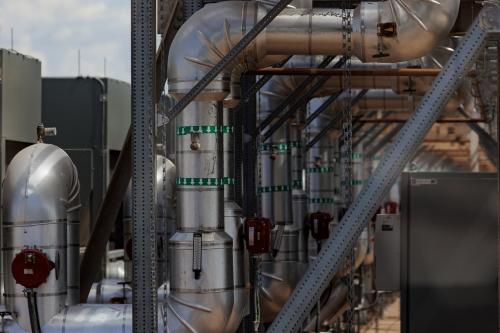Two decades from now, there are likely to be a number of Americans who travel using autonomous vehicles (AVs). In an article on Slate we assert that this emergent vehicle technology will inhibit the public sector’s ability to generate revenue. In our recently published report Local Government 2035 we explain how AVs will reduce cash flows to governments when speeding tickets, DUI’s, and towing fees are ostensibly eliminated by driverless systems. This was only one side of the coin; AVs will also increase safety and mitigate inefficiencies in transportation systems, thereby saving government and taxpayers big bucks.
Safer than human drivers
AV’s stellar track record for safety provides numerous benefits. At present, driverless systems are in the infancy stage of development—numerous hurdles must still be overcome. Google’s self-driving vehicles, which are arguably the most technologically advanced, flounder when faced with inclement weather, deviations from the pre-planned route, and potholes or other obstructions. Yet despite these challenges, AVs are actually safer than human drivers. For example, Google’s driverless vehicles, which have logged over 1.7 million miles over nearly six years of testing, have been involved in fewer than a dozen accidents, none of which were attributable to system failure.
The heightened focus that Google (and other AV pioneers) place on safety will have far-reaching impacts. In 2014, motor vehicle accidents claimed 32,675 American lives. AV systems will undoubtedly eliminate most—if not all—of these casualties. The resulting transportation environment will meet safety goals that civil servants within state and federal agencies have long strived towards. According to David Strickland, former administrator for the National Highway Traffic Safety Administration (NHTSA), “For the past 40 years, we’ve been working on protecting people from the crash. This [AV systems] is the new North Star, making sure the crash never happens.”
Lowering public costs
However, AV systems do more than just save lives; they will also save government billions. Consider a report published by the NHTSA, which concludes that seven percent of vehicle crash costs are paid for by public revenues. Further disambiguation reveals that federal entities cough up 4 percent of this revenue while states and localities provide the remaining 3 percent. Given AVs’ potential for safety, it is not far-fetched to assume that self-driving cars will completely eliminate these expenditures, thereby saving taxpayers an estimated $10 billion each year.
In addition to safety related financial savings, driverless technologies will aid in the elimination of other inefficiencies within the US transportation system. Consider the current state of affairs: congestion, road damage, and unrealized safety improvements that waste valuable resources. Brookings economist Clifford Winston recently (conservatively) quantified the financial impact of these inefficiencies at $100 billion. While limited funding and poor policies have contributed to the sorry state of American transportation infrastructure, self-driving cars will likely resolve many of these issues without government intervention. In a recent paper, Winston and Purdue scholar Fred Mannering argue that:
“…driverless car technologies are quite likely to effectively leapfrog most of the existing technologies that the public sector could but has failed to implement to improve highway travel.”
The “leapfrog” effect will have numerous positive impacts. Driverless systems will expand roadway capacity and reduce congestion by using GPS technologies to efficiently route vehicles through traffic jams. Specifically, when congestion occurs, computerized systems will divert a certain percentage of vehicles off the highways and onto surface streets. This will cut travel times, reduce fuel wasted while sitting in traffic, and improve productivity. Moreover, AV systems will likely adjust routing patterns for trucks and other heavy vehicles to avoid vulnerable infrastructure, thereby cutting costs and preserving the lifespan of critical roadways, and bridges.
Vehicle-to-vehicle communications technologies also have great potential to eliminate transportation-related inefficiencies. Researchers at the University of Texas have been exploring autonomous intersection management (AIM) capabilities; rather than stopping at red lights, self-driving cars would communicate with other vehicles and a computerized “intersection manager” to schedule a timeslot through an intersection. This would allow cars to enter an intersection from all angles at once without smashing into another car—effectively eliminating wait times at intersections. For these technologies to work, nearly all vehicles on the roadways would need to have autonomous capabilities.
The cost savings that the government will likely experience as a result of reduced inefficiencies are difficult to project. However, a recent report from the Eno Center for Transportation estimates the annual economic benefit of AVs to be $211 billion. This estimate is based on a 50 percent adoption of self-driving technologies; at 90 percent, this figure more than doubles to $447 billion (much of this value would be translated to government).
Shifting tax revenue
None of this is meant to say that government will not need to adapt to changing times. Currently, government profits from human driving errors: DUI’s, towing fees, speeding tickets, et cetera. Driverless innovations will eliminate much of this revenue. Additionally, year-over-year, new innovations in transportation decrease federal and state revenues. Consider the financial losses that eco-friendly and electric vehicles incur on public sector entities, especially given that the federal gas tax has remained at $0.184 per gallon (unadjusted for inflation) since 1993. Moreover, the transportation sharing economy—led by Uber, Lyft, and others—has begun a trend towards decreased vehicle ownership (and therefore revenue losses associated with vehicle registration). Further, Uber is not subject to the same taxes as traditional taxi services; e.g., New York City cabs are taxed $0.50 per trip whereas Uber is exempt. Therefore, it is critical that the public sector embrace new approaches to transportation taxation.
Even if the public sector refuses to innovate, government entities will save big bucks from the impending driverless car revolution. Billions will be saved as a result of increased safety and the reduction of transportation inefficiencies. The future is bright for autonomous vehicles.
The Brookings Institution is committed to quality, independence, and impact.
We are supported by a diverse array of funders. In line with our values and policies, each Brookings publication represents the sole views of its author(s).




Commentary
Autonomous vehicles will have tremendous impacts on government revenue
July 7, 2015